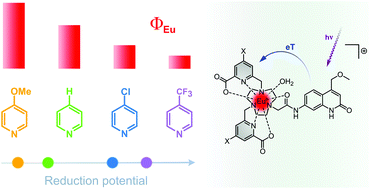Electron transfer pathways in photoexcited lanthanide(iii) complexes of picolinate ligands†
Abstract
A series of luminescent lanthanide(III) complexes consisting of 1,4,7-triazacyclononane frameworks and three secondary amide-linked carbostyril antennae were synthesised. The metal binding sites were augmented with two pyridylcarboxylate donors yielding octadentate ligands. The antennae carried methyl, methoxymethyl or trifluoromethyl substituents in their 4-positions, allowing for a range of excited state energies and antenna electronic properties. The 1H NMR spectra of the Eu(III) complexes were found to be analogous to each other. Similar results were obtained in the solid-state by single-crystal X-ray crystallography, which showed the structures to have nine-coordinate metal ions with heavily distorted tricapped trigonal prismatic geometries. Steady-state and time-resolved luminescence spectroscopy showed that the antennae could sensitize both Tb(III) and Eu(III), however, quantum yields were lower than in other octadentate complexes lacking pyridylcarboxylate. Complexes with more electron-poor pyridines were less emissive even when equipped with the same antenna. The oxidation and reduction potentials of the antennae and the pyridinecarboxylates, respectively, were determined by cyclic voltammetry. The obtained values were consistent with electron transfer from the excited antenna to the pyridine providing a previously unexplored quenching pathway that could efficiently compete with energy transfer to the lanthanide. These results show the crucial impact that photophysically innocent ligand binding sites can have on lanthanide luminescence.



 Please wait while we load your content...
Please wait while we load your content...